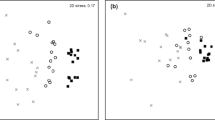Abstract
A benthic annular flume for both laboratory and in situ deployment on intertidal mudflats is described. The flume provides a means of quantifying material flux (i.e., biodeposition of suspended particulates, sediment resuspension, nutrients, oxygen, and contaminants) across the sediment-water interface in relation to changes in current velocity and benthic community structure and/or population density of key macrofauna species. Flume experiments have investigated the impact of the infaunal bivalveMacoma balthica and the epifaunal bivalveMytilus edulis on seston and sediment flux at the sediment-water interface. The bioturbatorMacoma was found to increase the sediment resuspension and/or erodability by 4-fold, at densities similar to those recorded at the Skeffling mudflat (Humber estuary) (i.e., >1000 individuals m−2). There was a significant correlation between sediment resuspension andMacoma density (r=0.99; p<0.001), which supported previous in situ field observations indicating bioturbation byMacoma enhanced sediment erodability. Biodeposition rates (g m−2 h1) ofMytilus edulis andCerastoderma edule were quantified and related to changes in population density in a mussel bed (Cleethorpes, Humber estuary). Biodeposition rates were up to 40-times the natural sedimentation rates. At the highest mussel bed densities (i.e., 50–100% cover or >1400 mussels m−2) the physical presence of this epifaunal bivalve on the sediment surface reduced erosion by 10-fold. The shift from net biodeposition to net erosion occurred at current velocities of 20–25 cm s−1. These results demonstrate that infaunal and epifaunal bivalves can have a significant impact on seston flux or sediment deposition and on sediment resuspension or erodability in estuaries where there are extensive mudflats.
Similar content being viewed by others
Literature Cited
Amos, C. L., J. Grant, G. R. Daborn, andK. Black. 1992. Sea Carousel—A benthic, annular flume.Estuarine, Coastal and Shelf Science 34:557–577.
Asmus, H., R. M. Asmus, andK. Reise. 1990. Exchange processes in an intertidal mussel bed: A Sylt-flume study in the Wadden Sea.Berichte der Biologischen Anstalt Helgoland 6:1–79.
Asmus, H., R. M. Asmus, T. C. Prins, N. Dankers, G. Francés, B. Maaß, andK. Reise. 1992. Benthic-pelagic flux rates on mussel beds: Tunnel and tidal flume methodology compared.Helgoländer Meeresuntersuchungen 46:341–361.
Black, K. S. andD. M. Paterson. 1997. Measurement of the erosion potential of cohesive marine sediments: A review of current in situ technology.Journal of Marine Environmental Engineering 4:43–83.
Dame, R. E., R. G. Zingmark, andE. Haskin. 1984. Oyster reefs as processors of estuarine materials.Journal of Experimental Marine Biology and Ecology 83:239–247.
Dyer, K. 1986. Estuarine and Coastal Sediment Dynamics. Wiley Interscience, Chichester, England.
Falconer, R. A. andP. H. Owens. 1990. Numerical modelling of suspended sediment fluxes in estuarine waters.Estuarine, Coastal and Shelf Science 31:745–762.
Fréchette, M., D. Lefaivre, andC. A. Butman. 1993. Bivalve feeding and the benthic boundary layer, p. 325–369.In R. F. Dame (ed.), Bivalve Filter Feeders in Estuarine and Coastal Ecosystem Processes. NATO ASI Series, Series G: Ecological Sciences. Volume 33. Springer-Verlag, Berlin.
Fukada, M. K. andW. Lick. 1980. The entrainment of cohesive sediment in freshwater.Journal of Geophysical Research 85:2813–2824.
Jaramillo, E., C. Bertrán, andA. Bravo. 1992. Mussel biodeposition in an estuary in southern Chile.Marine Ecology Progress Series 82:85–94.
Hansbo, S. 1957. A new approach to the determination of the shear strength of clay by the fall-cone test. Royal Swedish Geotechnical Institute. Proceedings No. 14:1–49.
Maa, J. P.-Y., L. D. Wright, C.-H. Lee, andT. W. Shannon. 1993. VIMS Sea Carousel: A field instrument for studying sediment transport.Marine Geology 115:271–287.
Meadows, P. S. andA. Meadows. 1991. The geotechnical and geochemical implications of bioturbation in marine sedimentary ecosystems.Symposium of the Zoological Society of London 63: 157–181.
Meadows, P. S. andJ. Tait. 1989. Modification of sediment permeability and shear strength by burrowing invertebrates.Marine Biology 101:75–82.
Navarro, J. M. andJ. Widdows. 1997. Feeding physiology ofCerastoderma edule (L.) in response to a wide range of seston concentrations.Marine Ecology Progress Series 152:175–186.
Prins, T. C. andA. C. Smaal. 1990. Benthic-pelagic coupling: The release of organic nutrients by an intertidal bed ofMytilus edulis, p. 89–103.In M. Barnes and R. N. Gibson (eds.), Trophic Relationships in the Marine Environment. Aberdeen University Press, Aberdeen, Scotland.
Rhoads, D. C. andL. F. Boyer. 1982. The effects of marine benthos on physical properties of sediments: A successional perspective, p. 3–52.In P. L. McCall and M. J. S. Tevesz (eds.), Animal-Sediment Relations: The Biogenic Alteration of Sediments. Plenum Press, New York.
Smaal, A. C., J. H. G. Verhagen, J. Coosen, andH. A. Haas. 1986. Interaction between seston quantity and quality and benthic suspension feeders in the Oosterschelde, the Netherlands.Ophelia 26:385–399.
Widdows, J., M. D. Brinsley, N. Bowley, andC. Barrett. 1998a. A benthic annular flume for in situ measurement of suspension feeding/biodeposition rates and erosion potential of intertidal cohesive sediments.Estuarine, Coastal and Shelf Science 46:27–38.
Widdows, J., M. D. Brinsley, and M. Elliott. 1998b. Use of in situ benthic annular flume to quantify particle flux (biodeposition rates and sediment erosion) for an intertidal mudflat in relation to changes in current velocity and benthic macrofauna, p. 85–97.In K. S. Black, D. M. Paterson, and A. Cramp (eds.), Sedimentary Processes in the Intertidal Zone. Geological Society, Special Publication 139. London, United Kingdom.
Widdows, J., P. Fieth, andC. M. Worrall. 1979. Relationships between seston, available food and feeding activity in the common mussel,Mytilus edulis.Marine Biology 50:195–207.
Author information
Authors and Affiliations
Corresponding author
Rights and permissions
About this article
Cite this article
Widdows, J., Brinsley, M.D., Salkeld, P.N. et al. Use of annular flumes to determine the influence of current velocity and bivalves on material flux at the sediment-water interface. Estuaries 21, 552–559 (1998). https://doi.org/10.2307/1353294
Received:
Accepted:
Issue Date:
DOI: https://doi.org/10.2307/1353294




